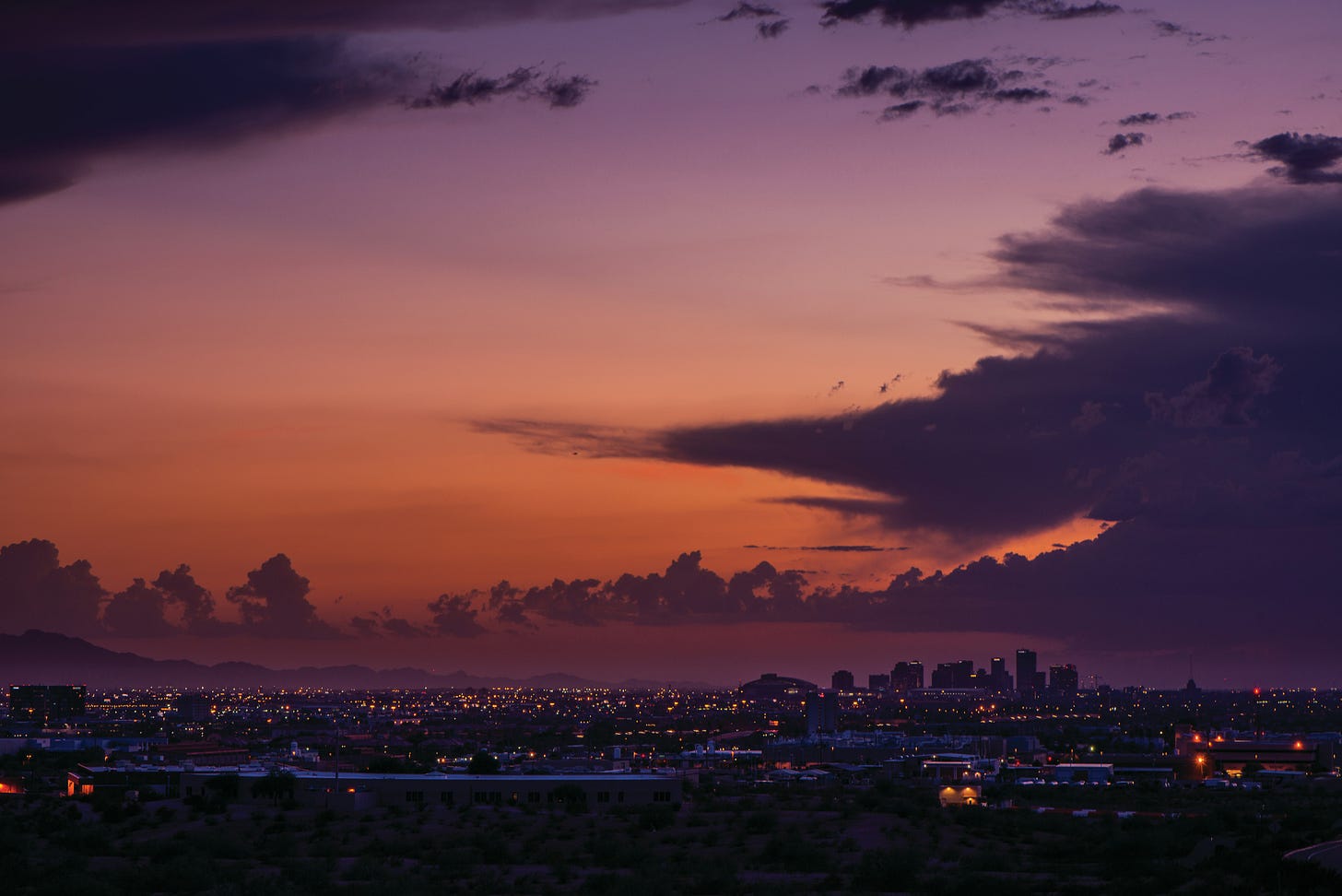Arizona’s Promethean Spirit
Hoping against hope, our ancestors imagined a Phoenix that would not only outpace other American desert civilizations, but emerge as a great American city.
Then God said, “Let us make mankind in our image, according to our likeness; and let them have dominion over the fish of the sea, and over the birds of the air, and over the cattle, and over all the wild animals of the earth, and over every creeping thing that creeps upon the earth.”
— Genesis 1:26-28
The world’s first major civilizations developed along waterways. Rivers are often embanked by fertile soil and floodplains, enabling the development of agriculture. They are conducive to commerce, because navigating a waterway eases the flow of goods, people, and ideas. Civilization flourishes where natural resources are readily available and where these resources can be traded with others. This wisdom holds true from ancient Egypt to modern America; the Nile to the Mississippi.
As mankind developed and matured, technological progress accelerated. Simple inventions like the spoke and wheel slowly but surely extended man’s dominion over the earth. In our industrial and postindustrial era, such innovations are manifold: Rockets fire men upward into the heavens and bring them back again, industrial agriculture enables the growth of crops in regions heretofore inhospitable to life, heavy machinery allows for the construction of continent-cutting canals. Nature, once man’s master, now bows to man’s designs.
Nowhere is this more true than in the American West. And long before European settlers extended their imperial ambitions westward, American Indians bent nature in their favor.
The Hohokam, a tribe that made home in modern day Arizona, constructed the largest pre-Columbian canal system in the Americas beginning in approximately 600 AD. Unable to provide for the food needs of a growing population, the Hohokam irrigated what is now the Phoenix valley. These desert people built out over 100 miles of canal. The flowing water enabled the Hohokam to flourish for hundreds of years, expanding their agricultural output and with it their civilization. At their height, these canals irrigated over 110,000 acres.
Source: David Abbott
The Hohokam vanished suddenly and mysteriously in the early 1500s (some historians posit a devastating drought), but vestiges of their canals lasted long after they disappeared. Many pioneers who flocked to Arizona in the 19th century noticed strange and winding channels tracing their way through creosote bush and cacti. Native peoples living in those parts no doubt shared oral histories of their ancestors constructing these ancient canals. These stories enraptured travelers, but few had the foresight, let alone the resources, to capitalize on these ancient designs.
For a long time, the Phoenix valley was considered an inopportune location for building a major city. Water is a crucial ingredient in cultivating a civilization. Prescott to the north and Tucson to the south were far more populous, and they traded the status of territorial capital until nearly 1890. Prescott was cooler and full of mineral wealth; Tucson had been developed by the Spaniards and remained Arizona’s most populous city through its territorial days and during early statehood. But some innovative settlers looked at the desolate valley’s old and dusted canals as more than a remnant of the past. These were the groundwork for a new future.
Hoping against hope, these pioneers imagined a Phoenix that would not only outpace other American desert civilizations, but emerge as a great American city.
Source: Arizona Archives, Carl T. Hayden Photograph Collection, 2062
“A city will rise phoenix-like, new and beautiful, from these ashes of the past,” wrote Phillip Darrell Duppa, an early Arizona pioneer. And indeed that Phoenix did rise. Following the American Civil War, Jack Swilling founded the Swilling Irrigating and Canal Company. He saw a business opportunity: Ranchers were willing to pay for someone to irrigate the Phoenix valley. Under Swilling’s leadership, the Salt River Valley was irrigated, making it open to agriculture for the first time since the Hohokam built their original canals. Many of the new canals followed the same path as the ancient channels.
Like most civilizations, Phoenix was built at the confluence of waterways: the Gila and the Salt Rivers. But it was not until man unlocked these waterways and their potential that civilization was made possible. Otherwise, the valley may have remained a sparsely populated region of the state, outperformed by its more populous neighbors to the north and south.
Phoenix’s history, as well as recent concerns about drought, have rightly made Arizonans concerned about water usage and skeptical of the long-term sustainability of our rapid growth. They’re right to be worried: After all, our desert civilization would simply not exist without forward-looking water management. The ghost of the Hohokam haunts every Phoenician: Will we suffer the same fate? And yet, such pessimism is far from the whole story.
Source: Shutterstock
Some look at Phoenix and other desert civilizations as monuments to man’s hubris. But I cannot help but find something deeply human in such striving. Despite 120-degree summer heat, despite drought after drought, despite all the vicissitudes of desert life, brave people have decided again and again to risk their lives in order to make a home for themselves among bramblebush and rolling sandstorms.
Our ancestors’ spirit of daring still satiates the Great American West, a sign not simply of man’s hubris but of his invincible soul.
Joe Pitts is a senior columnist at 1912. He serves as Chairman of the Board and CEO of the Western Tribune, a 501(c)(3) nonprofit news media company. He founded the company in 2021 alongside Clay Robinson.






